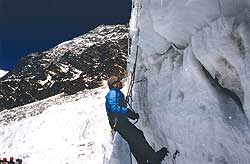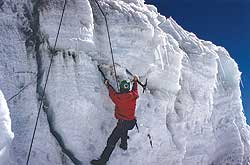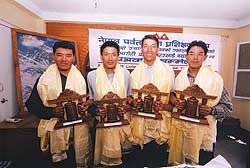 One fallout from the 50th anniversary hoopla of the ascent of Everest last month is that many Nepali youngsters suddenly want to learn to climb. And they are not just Sherpas.
One fallout from the 50th anniversary hoopla of the ascent of Everest last month is that many Nepali youngsters suddenly want to learn to climb. And they are not just Sherpas. So, the Nepal Mountaineering Association (NMA) climbing school in Manang (see pic, below) is gearing up to meet the rush. In addition, a group of veteran Nepali climbers have set up the Nepal Mountaineering Instructor Association (NMIA) with the view to encourage Nepal's youth to discover the wilderness, learn basic climbing techniques and undergo survival training.
NMIA was set up last year by three-time Everest summiteers, (from left to right in picture taken at the NMIA launch this week, below) Lhakpa Sherpa, Pemba Gyaljen Sherpa, Ang Norbu sherpa and Dorjee Lama. The group's professional instructors carry out training on rock climbing in Chewang in Solu Khumbu and in Nagarjun and Hatiban in Kathmandu. Ice and glacier traverse training is done in Langtang, basic mountaineering courses are carried out in Manang while advanced mountaineering courses take place in Thame.
"Mountaineering in Nepal is changing, it is no longer just about high altitude portering to make a living," says Padam Singh Ghaley of the instructors' association. "Many Nepalis now want to climb for the love of it, and there is a tremendous lack of proper training."
 The NMIA is collaborating with NMA to carry out specialised training in rock and ice, as well as in mountain rescue and survival. Some 15 trainees took part in a recent course in Langtang (see pics, above), and another course is planned in Manang this August. Since the two valleys lie in the rainshadow, the fallow monsoon months can be used for training.
The NMIA is collaborating with NMA to carry out specialised training in rock and ice, as well as in mountain rescue and survival. Some 15 trainees took part in a recent course in Langtang (see pics, above), and another course is planned in Manang this August. Since the two valleys lie in the rainshadow, the fallow monsoon months can be used for training. The NMA school in Manang was set up in 1975 with help from Yugoslavian climbers and has already produced 130 graduates. It still uses training manuals from France's Ecole nationale Aplisme et Ski (ENAS) and many of the instructors have been schooled in mountaineering training by professional instructors. "Although many of the applicants for mountaineering training are still Sherpas, there is a noticeable shift towards other communities," says NMIA chairman, Dawa Gombu Sherpa. "This is a healthy trend."
NMIA, with support from the Austrian group, Eco-Himal, is translating its mountaineering training handbooks into Nepali so that trainees as well as porters who don't know English can learn technical aspects like fixed rope climbing, glacier traversing, search and rescue and altitude sickness. "We hope the book will spread knowledge about safe climbing to a larger Nepali public," Ghaley told us.
 NMA is already self-sufficient because of the royalty it receives from trekking peak fees, and a part of its mandate is to popularise mountaineering activities among Nepali students and youngsters, according to its president, Ang Tsering Sherpa. "We want to spread awareness at both the national and international levels to preserve the beauty and challenge of the Himalaya," he says.
NMA is already self-sufficient because of the royalty it receives from trekking peak fees, and a part of its mandate is to popularise mountaineering activities among Nepali students and youngsters, according to its president, Ang Tsering Sherpa. "We want to spread awareness at both the national and international levels to preserve the beauty and challenge of the Himalaya," he says. NMIA is currently fundraising for its training programs, and is subcontracted by the NMA to carry out some of its courses, like the one in Langtang and Manang. "It is a mutually beneficial partnership," says Dawa Gombu. NMIA also wants to branch out and offer hiking and trekking experiences for schools in Kathmandu, Pokhara and Dharan so that Nepali children can learn about their country. "The programs will introduce Nepali children to trekking, mountaineering and basic techniques and wilderness survival training," explains Ghaley.
There are also inquiries from corporate groups in Nepal to organise challenging outdoor activities for their senior managers and executives. Business houses in Britain, France and the US regularly bring senior staff to Nepal for trekking to train them in teamwork, and NMIA thinks it can do the same for Nepali corporate houses.
"There are a lot of benefits: managers learn to work together, they gain self-confidence and they become better at problem-solving," says Ghaley. "This is not just about climbing, it prepares them to deal with life's adversities, and they also get to learn a lot about the diversity of their own country which is an added bonus."
[email protected]
www.nma.com


